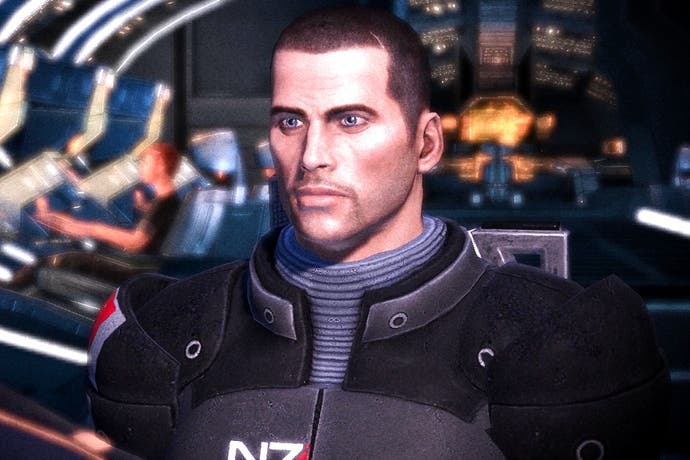Face-Off: Mass Effect on PS3
The original game comes to the Sony console with a range of improvements.
| - | Xbox 360 | PlayStation 3 |
|---|---|---|
| Disc Size | 6.9GB | 10.7GB |
| Install | 6.9GB (optional) | 3557MB (mandatory) |
| Surround Support | Dolby Digital | Dolby Digital, DTS, 5.1LPCM |
Five years on from its original release on the Xbox 360, developer BioWare has at last picked its moment to adapt the very first Mass Effect for PS3. This comes available as either a single PSN download or as part of the Mass Effect Trilogy collection - helpfully packaged alongside all relevant DLC, plus a patch to enable character imports in the later games. It's a great move for series completists, but much has come and gone since the game's first run on Microsoft's console in 2007. It's a product of its time, suffering as it does from severe frame-rate dips and texture pop-in, and with a lack of technical refinement that could seem out of place for a modern release.
This late showing on PS3 raises a big question, then; has this port been better optimised, or visually tweaked in line with the studio's stronger understanding of console hardware? Hopes in this vein are warranted, having already seen Mass Effect 2's delayed PS3 release introduce an overhauled approach to its lighting, thanks to the title running on what we were told was the previously-unseen Mass Effect 3 engine. A big effort was made there; though performance remained slightly behind on PS3 where transparent alpha filled the screen, the extra time investment paid off in a very handsome port indeed.
So let's get to the comparison, and see if the original game has been lavished with a similar degree of attention. Turning our analytical eyes to image quality matters first, we have an 80-strong Mass Effect comparison gallery and also our traditional head-to-head movie below.
"Five years on, Mass Effect is still a good-looking game - it's more refined on PlayStation 3 but it's missing motion blur and anti-aliasing."
The use of Unreal Engine 3 - present in a heavily modified state here - tends to come with the expectation of a 360 advantage, but we are talking about a much older build in this case. This has little bearing when comparing Mass Effect's native resolution, however, and we see both consoles producing matching 1280x720 frame-buffers. The issue of anti-aliasing is a little more complicated though.
Just like the sequel, there are strong traces of 2x multi-sampling AA on the 360, which masks the stair-stepping effect we see on high-contrast edges. This doesn't make an appearance on PS3, alas, though a post-processing pass on both platforms makes sure that jaggies are attended to, with the efficacy of this approach depending on how a scene is being lit. The net result is a game that looks smoother on 360, though the differences only become apparent in side-by-side shots.
"The tighter hit-detection and snap-to-cover mechanics in later games would have been great additions but alas it was not to be."
It's clear from the get-go that the core gameplay and controls of Mass Effect remain entirely unchanged in translation, which may strike some as a missed opportunity. The smooth snap-to-cover transitions of later games is missed, and in terms of gunplay, hit-detection after pulling the trigger isn't quite as consistent. Even so, we have a game that looks quite different from its original release on a number of levels, starting with its completely altered lighting system.
On first glance, it appears the 360 offers a brighter and more vivid image, with heavier bloom effect on weapons and spotlights, plus a more saturated use of reds. The PS3 release appears much duller in direct comparison, but it's clear that the positioning of light sources - both indoors and out - has a more natural impact on the way shadows play across the terrain. This is easiest to pick out around globally illuminated areas, such as the very first visit to the Eden Prime colony which has rocky outcrops and city barriers casting shadows at angles relative to the sun's position. Curiously, the 360 version often omits shadowing around these elements at a distance.
Elsewhere, Mass Effect's motion blur effect has seemingly been removed outright on the PS3 version, while the 360 comes out in full force with both a camera and a subtle per-object implementation. This strikes us as very odd indeed, considering the option to toggle the blur on and off is available in the menus for each release. Regardless of what we do in the menus, it remains absent during both cut-scenes and gameplay in motion on Sony's platform. It may come as a relief to some that the intensity of 360's classic film grain filter has been greatly reduced on PS3 too.
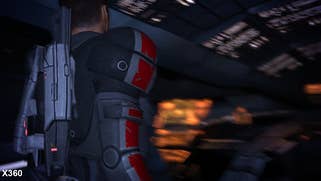
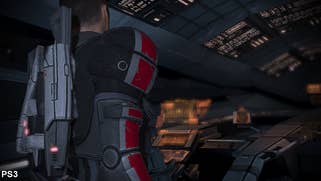
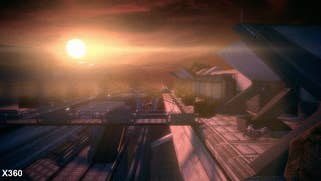



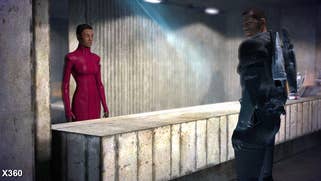
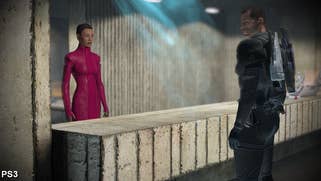
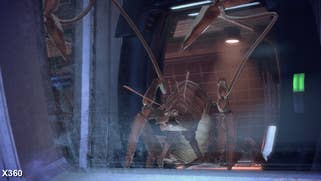
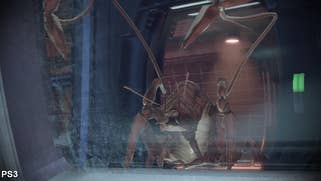
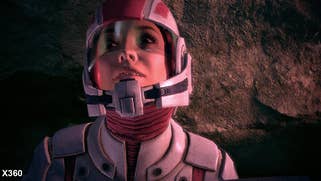
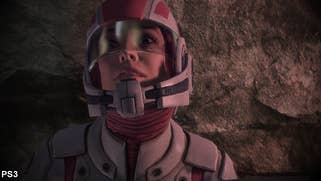
Save for a light smudging over of specular mapping for Sony's platform, details on major character models rely on the very same texture assets, and from similar approach to filtering. We do see some anomalous cases where the reflective properties of a character are missing entirely - but it's rare enough to be considered a glitch rather than a common trend in the PS3's visual quality. In all, we're looking at two games primarily divided by their use of light and shadow.
"A 3.5GB PlayStation 3 mandatory install in combination with improved streaming tech mostly resolves Mass Effect's infamous texture pop-in issues."
Texture pop-in has always scuppered the look of Mass Effect when played on 360, even once it became possible to install the game to the hard drive. It mainly affects scenes where the camera switches view during dialogue sequences or when first loading a new area, and this stays true during our tests with the game fully installed. To the PS3's benefit, the issue is made practically impossible to pick out in similar scenarios, showing a streaming process that has been optimised based on the advances made in later games.
Having the PS3's dedicated HDD to hand helps hugely here, where Mass Effect takes up just over 3.5GB via a mandatory install. Sadly, this doesn't put to rights the 'Loading' prompt that interrupts play while walking around the citadel - just as it does on 360 - or the lengthy bouts of loading disguised by elevator rides. The PS3 seems to also suffer for rapid transits around the Citadel in particular, where warping to Chora's Den for the first time (from the Citadel Tower) takes the 360 just 10.5 seconds, compared to double the time on PS3 at 21.5 seconds. This increase is consistent for many locations, and stands at odds with the PSN release, which is streaming entirely from the HDD.
On the topic of data differences, the PS3's larger disc size is taken up with DLC content, plus alternative language packs for German, Italian and French audio (weighing in at 1.62GB each). By contrast, the 360 only has the audio language specific to your game's region, and comes complete with 468MB of filler files, used to cover the remaining space on the DVD-9's first layer.
Mass Effect: performance analysis
Shifting our focus over to performance, the potential for improving on the 360's stuttering frame-rate and abundance of full-screen tearing is huge. We put cut-scene and traversal footage to the test to kick-start our analysis, with the hopes that five years' worth of experience working on the two consoles has aided with optimisations for PS3.
Standards have clearly changed over the last few years, and we're happy to say there aren't many games being released in a comparable state to Mass Effect on 360. The game runs with an adaptive v-sync that forces the games to alternate between 30FPS or 20FPS during scripted scenes, such as the dramatic discovery of the beacon in Eden Prime. Screen-tear crops up in small bursts here, with the odd frame being cut nearer the top throughout. This is taken to a greater extreme during dialogue with NPCs around the Citadel, however, where the tearing can begin to run riot across the whole screen.
"It's immediately apparent that Mass Effect on PlayStation 3 has a large performance boost over the original Xbox 360 version of the game."
By comparison, we're looking at a far smoother frame-rate on PS3 in likewise situations, usually holding at 30FPS where the 360 may fluctuate between numbers. It also happens to run without tearing a single frame, be it in cut-scenes or when running through a Citadel area packed with characters. Alas, there are still familiar weak points; drops to 15FPS are commonplace during sequences filled with transparent alpha effects, plus major hiccups down to 10FPS are possible when entering the Mako buggy. There also seems to be an issue with simply starting idle dialogue with squad members, which often causes a sharp stutter on each platform.
To really bring the frame-rate crumbling down though, we need to move towards more action-orientated slices of gameplay. We see huge gains in the first fight on Eden Prime with the electrified Husk enemies, for example, where Sony's hardware pushes out close to 30FPS throughout, while the 360 constantly hits the 20FPS line. This performance deficit on 360 is matched by equal amounts of tearing, which once again remains absent from the latest release on PS3. A very promising start overall.
However, a gunfight in the Chora's Den night-club soon shows us there's little to celebrate on the performance side, where we experience a sustained stretch of play at 15FPS on both platforms. In practice, this choppy level of feedback makes aiming at enemies very tricky indeed, though the PS3 does offer some respite by not tearing through the frames it does render out. This goes from bad to worse during a shoot-out in the Mako buggy, which sees us stuttering down to 10FPS at the sight of snow trails, rocket explosions and artillery fire. It isn't a pretty sight on either console once alpha effects are involved, and it's disappointing to see such glaring issues cropping up in a game released at the tail end of the generation.
"The implementation of v-sync on PS3 is a major boost, but frame-rates are far from consistent, with Mako shoot-outs reaching a nadir at 10FPS."
Mass Effect on PS3: the Digital Foundry verdict
The wait is over, and PS3 owners now have the ability to sculpt their own Shepard from the beginning of the Mass Effect series right the way through to the controversial conclusion. Technically, there are a swathe of genuine advantages to playing the latest Sony release too. To reel off a few of the major points: texture pop-in has been minimised hugely thanks to the install, frame-rates have been improved for cut-scenes, and there's now absolutely no screen-tearing throughout. There are a few design choices that may be preferable to some players as well, such as the reduced intensity of the bloom, and also the minimised film grain filter that characterises the game's 50s sci-fi aesthetic.
It's not a perfect transition though. Negatives points such as the lower-resolution normal maps may pass many players by, especially without an alternative image to compare it to. However, the use of flickering PCF shadows on character faces stick out even more than the 360's dithered approach, and produces sharp bands of shade across enclosed environments too. It's also a shame to see the PS3 can't break away from the incessant 15FPS feedback around Chora's Den or Noveria's wintry cliff-sides. In this respect, it's only marginally improved over the 360 in the performance stakes.
Extra content is factor too, and may be the clincher for those eyeing up the Mass Effect Trilogy package on PS3. While the 'Pinnacle Station' DLC hasn't made the cut due to issues with the source code, the 'Bring Down the Sky' pack does come bundled with this release at no extra cost. However, both add-ons have been inexplicably chopped from the inventory of the 360 collection, so to complete the set there, you'll need to visit the Marketplace [Updated: Pinnacle Station info corrected]. In all, the PS3 edition hangs on to many of the horrid performance spikes that we hoped would be eroded by time. It's a noticeable step forward that matches up to the competition favourably, but we can't help but feel the opportunity to give the game a more radical make-over has been missed.
